Género e inclusión
El género, la edad, las capacidades y otras características individuales o específicas del contexto presentan diferentes oportunidades y retos para proporcionar PTM a las personas en crisis de forma digna.
Los agentes humanitarios reconocen cada vez más las necesidades y limitaciones específicas de las personas con capacidades diferentes, las personas mayores, las personas de distinto sexo, en particular las mujeres, y las personas en movimiento. Paralelamente, se aprecia cada vez más la necesidad de adoptar medidas adaptadas y sensibles que garanticen su inclusión efectiva.
Apoyar las necesidades de las diversas personas con PTM va más allá de convertirlas en un grupo objetivo; se trata de un compromiso significativo, un diseño y una implementación intencionados, y un ajuste del programa para satisfacer las necesidades de los diferentes grupos con dignidad. Los enfoques inclusivos van de la mano de la ayuda centrada en las personas.
Prioridades actuales
La CALP Network seguirá animando a los actores de los programas de transferencias monetarias a que amplíen su enfoque para ser más inclusivos y defiendan una comprensión más completa de cómo los PTM pueden ir más allá de la noción de “no hacer daño” para abordar adecuadamente las necesidades de personas diversas de manera segura y digna.
Trabajaremos para elevar las experiencias e iniciativas sobre PTM y género, PTM inclusivos de la discapacidad, trabajando con diferentes etnias e identidades culturales, grupos minoritarios, personas con diversas identidades sexuales y grupos de edad.
CALP también se esforzará por hacer su trabajo lo más accesible posible.
Contenido destacado

La CALP Network & CARE: Módulo sobre los Programas de Transferencias Monetarias (PTM) y Género
Blog Post
Este video ofrece una visión general de la relación entre el género y los programas de transferencias monetarias (PTM) estructurada en torno al ciclo del proyecto humanitario, que incluye: Evaluación y análisis de la respuesta: cómo ajustar los procesos de evaluación para lograr un reflejo más preciso del género y los mercados. Diseño y ejecución: cómo utilizar métodos y...

Presentación: Módulo sobre Programas de Transferencias Monetarias (PTM) y Género
Presentación
Esta presentación de diapositivas es parte del primer vídeo de micro aprendizaje de CALP Network en español, realizado en colaboración con CARE. Este módulo de micro aprendizaje ofrece un panorama general de la relación entre el género y los Programas de Transferencias Monetarias (PTM) organizado en torno al ciclo de proyecto humanitario, y forma parte del curso en línea en español de...
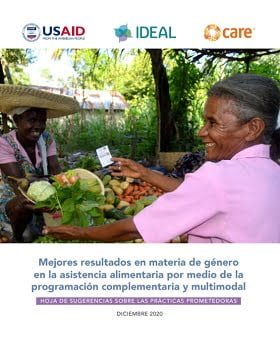
Mejores resultados en materia de género en la asistencia alimentaria por medio de la programación complementaria y multimodal: hoja de sugerencias sobre las prácticas prometedoras
Guía y herramientas
Esta hoja de sugerencias es un extracto del informe de investigación «Mejores resultados en materia de género en la asistencia alimentaria por medio de la programación complementaria y multimodal». Con el estudio, se intentó responder a la pregunta «¿De qué manera los procesos de diseño, implementación y supervisión de proyectos mediante el uso de modalidades combinadas mejoran los...
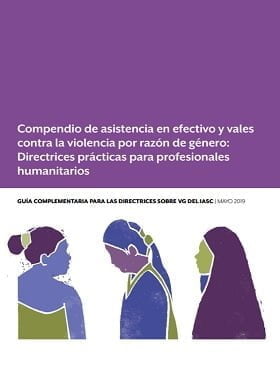
Compendio de asistencia en efectivo y vales contra la violencia por razón de género: Directrices prácticas para profesionales humanitarios
Guía y herramientas
El propósito de este compendio de asistencia en efectivo y vales (AEV) y violencia por razón de género (VG) es ayudar a los actores humanitarios y a las comunidades afectadas por crisis y violencia a: integrar la mitigación de riesgos de VG en las intervenciones AEV; integrar la prevención de VG en la programación multisectorial usando AEV cuando corresponda; integrar la AEV en la...

Programación de Transferencias Monetarias Que Funciona Para Mujeres: 6 Lecciones del Terreno
Informe
En la actualidad, la Programación de Transferencias Monetarías que funciona para mujeres (PTM) es una herramienta común entre las acciones humanitarias y se usa para satisfacer las diversas necesidades de las personas desplazadas por crisis y conflictos con mayor dignidad.1 Aunque existe evidencia cada vez mayor sobre el efecto de la PTM en el bienestar y el poder de las mujeres2, en la...
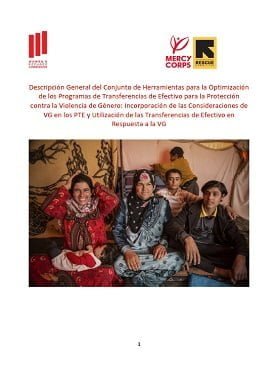
Conjunto de Herramientas para la Optimización de los Programas de Transferencias de Efectivo para la Protección contra la Violencia de Género
Guía y herramientas
De 2016 a 2018, la Comisión de Mujeres Refugiadas (WRC) emprendió un proyecto para desarrollar la capacidad que los actores humanitarios tienen para integrar la protección en los Programas de Transferencias de Efectivo (PTE) y para utilizar los PTE para los resultados de protección, específicamente la protección contra la Violencia de Género (VG). El proyecto, “Optimización de los...
Últimos recursos

Can E-transfers Promote Financial Inclusion in Emergencies: A Case Study from Bangladesh
Report
The Electronic Cash Transfer Learning Action Network (ELAN) launched research to build an evidence base around connecting emergency electronic transfer (e-transfer) recipients with additional financial services. They wanted to learn if, when, and how e-transfers can promote sustained uptake and use...

Evaluation of the Kenya Hunger Safety Net Programme Phase 2
Report
The report summaries key findings from Hunger Safety Net Programme Phase 2 Qualitative impact study conducted in August 2016. The report integrates interesting infographics that depict the findings in an easy to read and understand format

IOM Cash-Based Transfer – Update and Case Studies
Report
Cash-based transfers have a long history in the support of people on the move. Cash or vouchers have been an element of the International Organization for Migration’s resettlement support for people moving to new countries, or returning to countries they had to leave. Increasingly over the last decade,...
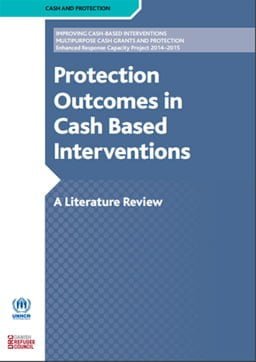
Protection Outcomes in Cash-based Interventions: A Literature Review
Report
This literature review examines existing research to determine whether the use of cash and vouchers is contributing to the promotion of protection and gender outcomes for beneficiary communities, following the WFP and UNHCR 2013 study on gender, protection and cash. This literature review focuses on these...
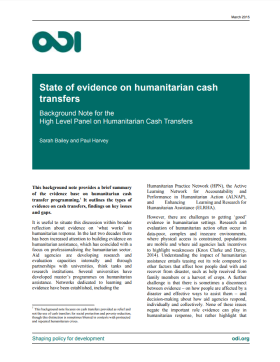
State of Evidence on Humanitarian Cash Transfers
Policy paper
The “State of evidence on humanitarian cash transfers” background note provides a brief summary of the evidence base on humanitarian cash transfer programming. The report also outlines the types of evidence on cash transfers, findings on key issues and gaps. This publication is an output of the...

A Review of Evidence of Humanitarian Cash Transfer Programming in Urban Areas
Report
Urban poor populations frequently experience disasters of varying typology and intensity. When set against a backdrop of poverty and marginalisation, their needs can be complex. As recent urban crises have pushed humanitarian agencies to respond in urban areas, this literature review examines the...

A Review of Evidence of Humanitarian Cash Transfer Programming in Urban Areas: Annexes
Report
Annexes to accompany the working paper ‘A review of evidence
of humanitarian cash transfer programming in urban areas”

Guide for Protection in Cash based Interventions
Guidelines and Tools
This guide identifies minimum necessary information and key resources needed to help humanitarian practitioners ensure that protection risks and benefits are considered and monitored throughout the cash-based interventions (CBI) program cycle, using a community-based approach and participatory methods as...

Feasibility of cash transfer modalities in refugee settlements
Report
The main objective of this market assessment was to determine market functionality and the feasibility of cash transfer modality (and use of mobile money) among refugee settlements (Kyangwali, Kyaka II, Rwamwanja and Koboko) proposed for the cash transfer scale up in 2016. Survey households were randomly...

Integrating Gender throughout a Project’s Life cycle 2.0: A Guidance Document for International Development Organisations and Practitioners
Guidelines and Tools
The overarching premise of this document is that to conduct effective, responsible development work, incorporating gender at all stages of a project’s life cycle – from project design and proposal development to field implementation and monitoring, evaluation and learning – is critical. As such,...

Tips for Protection in Cash based interventions
Guidelines and Tools
This document presents a set of general tips to identify, monitor and mitigate protection risks and maximize protection benefits of cash-based interventions.
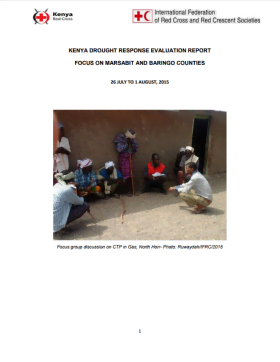
Kenya Drought Response Evaluation Report – Focus on Marsabit and Baringo Counties
Report
An evaluation of a drought response which involved school feeding, cash transfers and nutrition outreach activities.

Enhancing Food Security and Nutrition during the First 1000 Days through Gender-sensitive Social and Behavioural Change: A Technical Resource Guide
Guidelines and Tools
This technical resource guide is designed to build the capacity of development practitioners working in nutrition and food security to plan, implement, and evaluate gender-sensitive SBC programming in order to improve nutritional outcomes for pregnant and lactating women (PLW) and children under two. It...
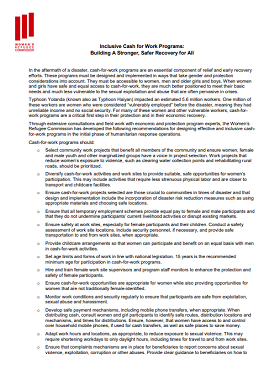
Inclusive Cash for Work Programs: Building A Stronger, Safer Recovery for All
Report
In the aftermath of a disaster, cash-for-work programs are an essential component of relief and early recovery efforts. These programs must be designed and implemented in ways that take gender and protection considerations into account. They must be accessible to women, men and older girls and boys. When...

Integrating Cash Transfers into Gender-Based Violence Programs in Jordan: Benefits, risks and challenges
Report
With limited global practice and guidance on programming cash transfers to enhance protection in an emergency context, in 2013, the International Rescue Committee’s (IRC) started cash transfer programming (CTP) as part of the urban Women’s Protection and Empowerment (WPE) program in Jordan. Three...

Cash Transfer Programming for Syrian Refugees: Lessons Learned on Vulnerability, Targeting, and Protection from the Danish Refugee Council’s E-Voucher Intervention in Southern Turkey
Report
DRC Turkey is currently implementing a two-year, DFID-funded project that aims to provide immediate support to and strengthen the coping mechanisms of vulnerable non-camp Syrian refugees in southern Turkey. The first phase of the project focused on identifying and providing monthly cash transfers (in the...

The Impact of Cash Transfer Programmes on Protection Outcomes in Afghanistan
Report
Although cash-based interventions (CBIs) are increasingly used to deliver humanitarian assistance in support of more traditional in-kind emergency distributions, there is now a growing, global acceptance among stakeholders of the need to pay closer attention to the positive and negative impact of CBIs on...
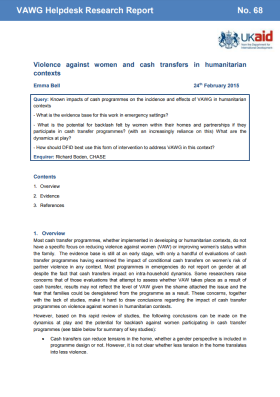
Violence Against Women and Cash Transfers in Humanitarian Contexts
Policy paper
This report addresses the known impacts of cash programmes on the incidence of violence against women in humanitarian contexts. Query: Known impacts of cash programmes on the incidence and effects of VAWG in humanitarian contexts What is the evidence base for this work in emergency settings? What is the...
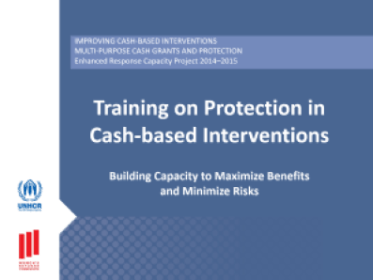
Protection in Cash-based Interventions Training: Building capacity to maximize benefits and minimize risks
Guidelines and Tools
This participatory curriculum is based on the inter-agency Guide for Protection in Cash-based Interventions (CBIs). The one-day training provides practical instruction for analysing and monitoring protection risks and benefits in CBIs. Slides, facilitators’ guide, case studies, and other materials for...

2015 State of the Industry Report. Mobile Money
Report
Mobile money is reaching more than 411 million people globally. Moreover, it is available in 85% of countries where the vast majority of the population lacks access to a formal financial institution. This is an extraordinary achievement, demonstrating the power of mobile, underpinned by the critical...


